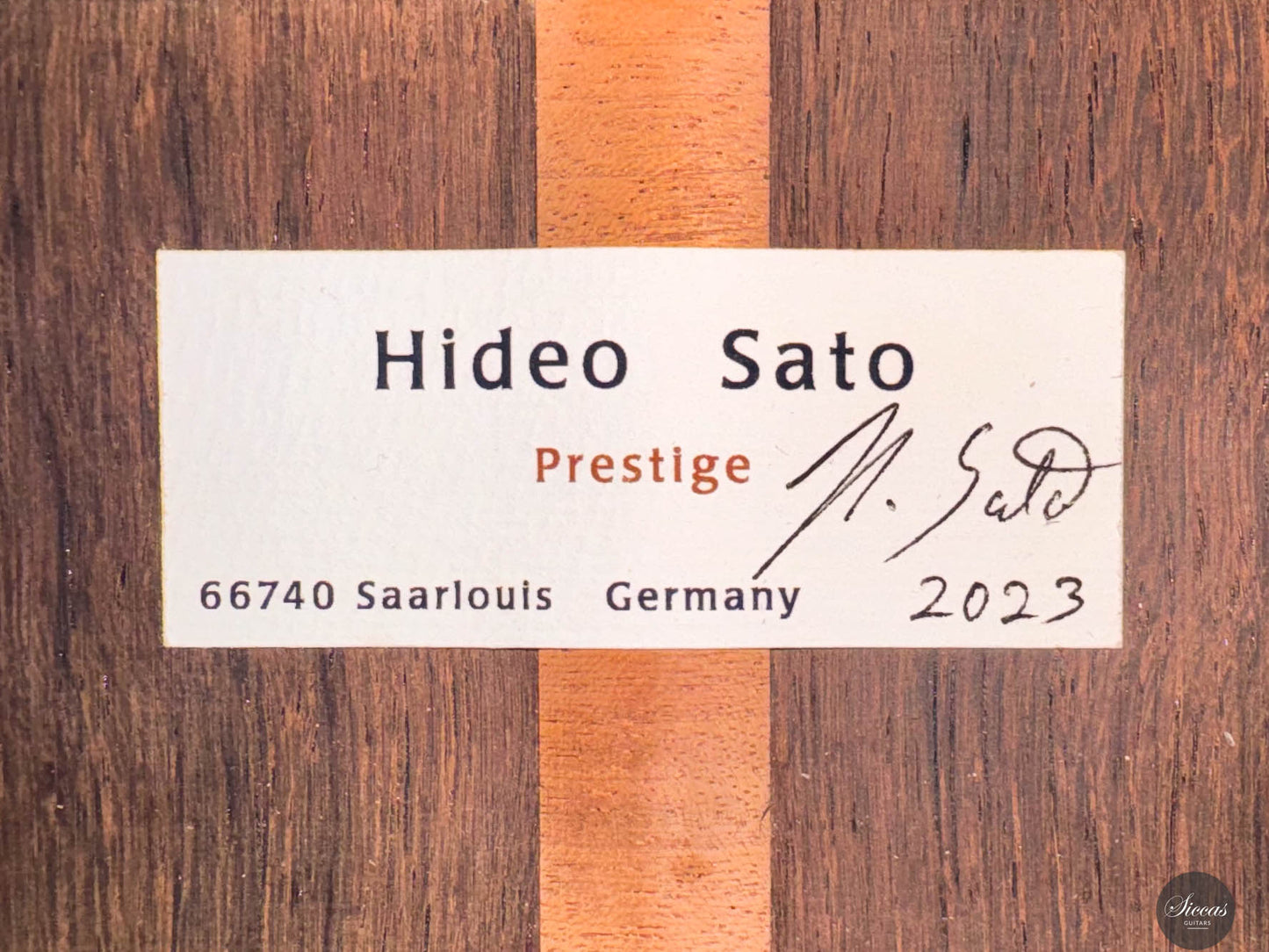Hideo Sato - 2023 - Prestige - 65 cm
Hideo Sato - 2023 - Prestige - 65 cm
Details
Details
Overview
Overview
Shipping important note
Shipping important note
Delivery times are typically reliable and most instruments arrive within the estimated timeframe.
Should any unexpected delay occur, our team will keep you informed and provide support at every step. For all shipping details and exceptions, please see our Shipping Policy.
Details about GPSR
Details about GPSR





















Video overview


More details about the guitar
About the luthier
Kazuo Sato is an internationally renowned luthier who apprenticed with Kuniharu Nobe in Japan from 1965 to 1971. After that period, he moved to David Rubio’s workshop in England, where he worked along with another famous luthier: Paul Fischer. In 1974 he established his own workshop in Germany. He is still based in Germany and now also works together with his son Hideo Sato. His son Hideo, who, like his brother, learned classical guitar with Prof. Ansgar Krause, followed the activities in the workshop with great interest from an early age. In 2011, despite a promising career in the software industry in Japan, he decided to dedicate himself entirely to guitar making. After several years of apprenticeship, he builds classical concert guitars together with his father. Hideo utilizes his father’s rich wealth of experience as a foundation for realizing his own ideas. Even his first instruments were played and appreciated by well-known guitarists and professors.About the guitar
The “Prestige” model by Hideo Sato stands as a pinnacle of craftsmanship, nestling at the very top of his guitar lineup. Crafted with highly figured Madagascar rosewood for the back and sides, this guitar is not just a musical instrument but a piece of art, distinguished by its remarkable quality and stunning appearance. One of the most striking features of the “Prestige” model is its exceptional projection, making it an ideal choice for concert performances. The rich tonal colors, warm timbre, and exceptional sensitivity of this guitar offer musicians a spectrum of expressive possibilities, allowing for a deeply personal and nuanced musical exploration. Built in 2023, the guitar remains in excellent condition, showing only superficial signs of play, a testament to its durable craftsmanship and the care it has received.Despite its near-pristine condition, the “Prestige” model has one repaired hairline crack on the Madagascar rosewood back—a minor flaw that is not uncommon for this type of wood and is considered purely cosmetic. The repair, expertly carried out at the Sato workshop, underscores the meticulous attention to detail and commitment to excellence synonymous with Hideo Sato’s work. This minor imperfection does not affect the guitar’s sound quality, ensuring that the instrument’s tonal integrity remains uncompromised. Owning a Hideo Sato “Prestige” model built in the latest year represents a unique opportunity for enthusiasts and professionals alike to acquire a top-of-the-line instrument without the usual waiting time and at a sensible price. This guitar embodies the perfect blend of aesthetic beauty, exceptional playability, and sonic excellence, making it a coveted piece for any serious guitarist’s collection.
Regular care extends the life of the instrument
Even with careful use, a classical guitar may gradually change in appearance or respond to unstable storage conditions. Have a close look at your guitar regularly and be attentif to changes. If your instrument is suffering from its environement, it will let you know.
Protect Your Guitar: Handle with Care
Be mindful when touching your instrument with greasy or unwashed hands: any skin contact is a small attack on the varnish. Of course, a guitar is made to be played, but taking a few precautions helps preserve its beauty: wash your hands before playing, wear long sleeves, and avoid unnecessary direct skin contact with the body of the instrument.
Pro tip: Avoid playing with a button-up shirt, heavy jewelry, or a belt, as these can scratch the guitar. Also, make sure your guitar case is free of any objects that could damage the instrument during storage.
String care
A good habit to adopt is wiping down your strings briefly after each playing session. This small action significantly extends their lifespan and helps maintain a consistent, comfortable feel under your fingers.
Most importantly, clean strings are essential for keeping your instrument in tune. Corrosion, sweat, and dust can affect the uniformity of the strings and interfere with accurate tuning across the entire fingerboard.
Pro tip: If you're having trouble getting your guitar in tune, it might be time to change the strings. A useful test is to compare the pitch of the 12th fret harmonic with the fretted note at the 12th fret; if there's an unusually large gap between them, your strings may have lost their integrity and should be replaced.
Keep Your Shellac Finish Shining!
Got a guitar with a shellac (French polish) finish? Here's a simple trick: Take a clean microfiber cloth and gently breathe on the surface to create a light mist. Then, softly rub to remove fingerprints, sweat, and grease. That’s usually all it takes to keep it looking great, no products needed!
Pro tip: Every few years, treat your guitar to a check-up with a luthier to keep it in top shape.
Storing Your Guitar: Climate Matters
Your guitar can safely stay outside its case, as long as the surrounding environment maintains 42–55% humidity and a temperature between 18–25°C.
Keep in mind that humidity levels can still fluctuate inside the case, especially during seasonal changes.
- Too much humidity may cause overtightened strings and a dull tone.
- Too little humidity can lead to a bulging top, string buzz, or even cracks.
Avoid placing your guitar near radiators, air conditioners, or windows with direct sunlight.
Pro tip: Always close your guitar case while playing. This helps preserve a stable microclimate inside the case, so your instrument is protected the moment you put it back in.













































